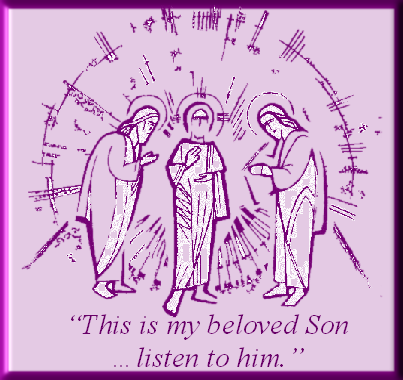Theme: The Transfiguration: A Shining Moment at the Heart of Creation
The second Sunday of Lent presents us with the story of the Transfiguration of Jesus. This year the account is taken from the Gospel of Matthew. Jesus leads three of his beloved disciples up a high mountain and there offers them a glimpse of his glory. If we are feeling faint-hearted and unresponsive to this season of grace – ‘carrying the weight of the world on our shoulders’ – this is a moment intended to lift our spirits. It is a shining moment at the heart of creation, made glorious by the presence of Jesus at its centre.
The Transfiguration takes place at a critical moment in Jesus’ life and ministry. He has left behind the beautiful green valleys and gentle rolling hills of Galilee and taken the road to Jerusalem where violent death awaits him. He realises that in Jerusalem he will meet the same fate as the prophets met before him. He had already warned his disciples ‘that he was destined to go to Jerusalem and suffer grievously at the hands of the elders and chief priests and scribes, to be put to death and to be raised up on the third day’ (Mt 16: 21). When Peter began to remonstrate with him, refusing to accept his prophetic words, he rebuked him in unusually harsh terms: ‘Get behind me, Satan! You are an obstacle in my path, because they way you think is not God’s way but man’s’ (Mt 16:23). Jesus’ suffering and death are part and parcel of his salvific mission.
As was Jesus’ custom when facing into danger, he withdraws to a mountain to pray and reflect, taking with him Peter, James and John. In their presence he is transfigured – ‘his face shone like the sun and his face became as white as the light’ (Mt17: 2). And he appears in conversation with Moses and Elijah. Then, as on the occasion of his baptism, a voice from ‘a bright cloud’, the voice of his Father, affirms his divine identity and messianic vocation: ‘This is my Son, the Beloved; he enjoys my favour. Listen to him’ (Mt 17:7). This affirmation and confirmation of the Father’s love must surely have strengthened him in the face of the dark and threatening future that lay ahead.
The transfiguration experience was important not just for Jesus but even more so for his beloved disciples. Their eyes are opened to catch a glimpse of Jesus in his glory and their ears are opened to hear the divine confirmation of Jesus’ identity as ‘beloved Son’ to whom they are commanded to listen. Captivated by the experience, Peter wishes to remain on the mountain in the exalted company of Elijah, Moses and Jesus. However, this is not to be. The luminous moment passes and the three disciples find themselves alone with Jesus who warns them not to tell anyone about what they had seen ‘until the Son of Man has risen from the dead’ (Mt 17:9).
The fact that the story of the transfiguration of Jesus is recounted in all three synoptic gospels – Matthew, Mark and Luke – shows its importance and significance for the early Christian community. In the words of the popular New Testament scholar, Thomas Wright: ‘It demonstrates, for those with eyes to see, and ears to hear, that Jesus is the place where God’s world and ours meet…. As with everything else in the gospel narrative, the moment is extraordinary but soon over. It forms part of a new set of signposts, Jesus-shaped signposts, indicating what is to come: a whole new creation, starting with Jesus himself as the seed that is sown in the earth and then rises to become the beginning of that new world’ (from his book, Simply Jesus, p. 144).
Today’s gospel may prompt us to recall transfiguration moments in our own lives – moments of light, joy and peace; moments in which we caught a glimpse of a transcendent beauty beyond the horizon of the habitual; moments that, in the words of the poet, Seamus Heaney, ‘catch the heart off guard and blow it open’. Such moments may not transform us, for they are always fleeting, But they do heighten our awareness of a sustaining presence that helps us cope with times of fear and uncertainty, and carry us forward in hope of ‘a new world in the morning’ (Roger Whittaker). Lent is a time to remember such moments and draw strength from them. It is a time to trust in the Lord, like Abraham in our first reading, even when the odds seem stacked against us. It is a time to trust in the grace already granted to us in Christ Jesus, as St Paul reminds us in our second reading, as we continue our journey towards Easter. I will end with an inspiring evocation of the Transfiguration by the contemporary Anglican poet, Malcolm Guite.
For that one moment, ‘in and out of time’,
On that one mountain where all moments meet,
The daily veil that covers the sublime
In darkling glass fell dazzled at his feet.
There were no angels full of eyes and wings,
Just living glory full of truth and grace.
The Love that dances at the heart of things
Shone out upon us from a human face,
And to that light the light in us leaped up,
We felt it quicken somewhere deep within,
A sudden blaze of long-extinguished hope
Trembled and tingled through the tender skin.
Nor can this this blackened sky, this darkened scar
Eclipse that glimpse of how things really are
Michael McCabe SMA
To listen to an alternative Homily for this Sunday, from Fr Tom Casey of the SMA Media Centre, Ndola, Zambia please click on the play button below.

